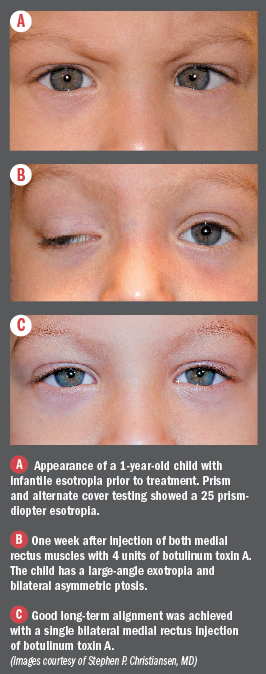Article
New drugs, devices take strabismus to next level
The surgical procedures and botulinum toxin A injections widely used today to treat strabismus may be supplanted within a decade or two by new drugs and devices that are more effective.
Take-home:
The surgical procedures and botulinum toxin A injections widely used today to treat strabismus may be supplanted within a decade or two by new drugs and devices that are more effective.
By Nancy Groves; Reviewed by Stephen P. Christiansen, MD
Boston-Though strabismus treatment in children is generally effective, investigators have taken action to improve the success rate further by investigating new drugs and developing new devices.
Currently, ophthalmologists seeking to reassure parents of children requiring treatment for strabismus often cite an 80% success rate for the surgical procedure.
This is “simply inaccurate,” said Stephen P. Christiansen, MD, noting that the overall re-operation rate for infantile esotropia is about 34%, and for exotropia it approaches 80%.
“We have seen some changes in the way we treat patients over these last few years,” said Dr. Christiansen, chairman and professor of ophthalmology and pediatrics, Boston University School of Medicine. “But I expect that within 20 years or so the way we treat patients with strabismus will have changed dramatically.”
“We have to recognize that if we are doing a mechanical operation for a disease that is principally electrical, there are going to be long-term changes in eye alignment because the electrical system changes over time,” he said.

Development of devices
On the devices front, one of the promising new approaches is a titanium T-plate anchoring platform system that could be particularly helpful as a means for ocular alignment in patients with severe paralytic and restrictive strabismus, Dr. Christiansen said.
The plate is attached to the nasal orbital wall, and the extraocular muscle insertion is tethered to the posterior plate. Hilda Capo, MD, and David T. Tse, MD, both of Bascom Palmer Eye Institute, University of Miami Miller School of Medicine, developed the T-plate system, introduced in 2010.
Pipeline for pharmaceuticals
Among pharmaceutical approaches, botulinum toxin A (BTX-A) has been used in strabismus treatment for more than 30 years, but it’s time for re-assessment, Dr. Christiansen suggested. BTX-A may lack the power to adequately control the alignment in patients with large angles, especially with a single injection, although it may still be appropriate in patients with smaller angles, residual strabismus after recession, or consecutive strabismus.
Analyzing all cases of strabismus treatment with BTX-A, about 50% of children with infantile esotropia will require re-injection. But in children who have smaller angles (< ±35 PD), reports are as good as 63% alignment within 8 PD of straight (range 34 to 63).
In a study by Tejedor and Rodriguez (IOVS, 2001), the success rate was 53% aligned for patients with acquired esotropia following a single injection (mean ET = 35 PD). Analysis by A. de Alba et al. (Archives of Ophthalmology, 2010) demonstrated that use of BTX-A has an extremely low rate of consecutive exotropia, <3% for all treated patients.
“Although these patients haven’t been followed for long periods of time, it looks like BTX-A may result in good long-term alignment with relatively low consecutive exodeviations,” Dr. Christiansen said.
Pros, cons botulinum toxin A
BTX-A treatment has limitations as well as advantages. For instance, it has a limited duration of action and can only weaken, not strengthen, the extraocular muscles. It also has a relatively modest effect on alignment with a single injection, and there are no long-term decreases in force generation.
As a result, many patients need re-injections.
“Parents do not like that,” Dr. Christiansen said. ”They want their child taken care of in a single operation.”
Another issue with BTX-A is orbital leakage accompanying the injection, which can have collateral effects on other extraocular muscles and perhaps on the ciliary ganglion. Tonic pupil has also been reported following BTX-A injection.
These drawbacks have sent investigators in pursuit of an ideal agent for strabismus that would be titratable, last long enough for sensory and motor adaptation to occur, create permanent change in the globe’s rotational position, and would not create significant inflammation or cause unwanted collateral damage, Dr. Christiansen said.
Other innovations
Growth factors, such as IGF I and II, are showing excellent results so far. These agents increase motor strength, giving surgeons a way to both weaken and strengthen the muscle. Toxins besides BTX-A are being studied, as are immunotoxins (ricin-mAb 35 and other fusion proteins).
Injection of the anesthetic bupivacaine, an off-label use of this agent, is another innovation in strabismus treatment, first advocated by Alan B. Scott, MD, of the Smith-Kettlewell Eye Institute, San Francisco, about 8 years ago. Bupivacaine causes fiber hypertrophy, creating large, stiff muscles.
“Bupivacaine by itself doesn’t have a huge effect on alignment, but if you weaken a rectus muscle with BTX-A and strengthen the antagonist with bupivacaine, you do get a significant change in the rotation,” Dr. Christiansen said.
Stephen P. Christiansen, MD
P: 617/414-4020
Dr. Christiansen did not report any financial interests or relationships.
Subscribe to Ophthalmology Times to receive the latest clinical news and updates for ophthalmologists.
Newsletter
Don’t miss out—get Ophthalmology Times updates on the latest clinical advancements and expert interviews, straight to your inbox.




